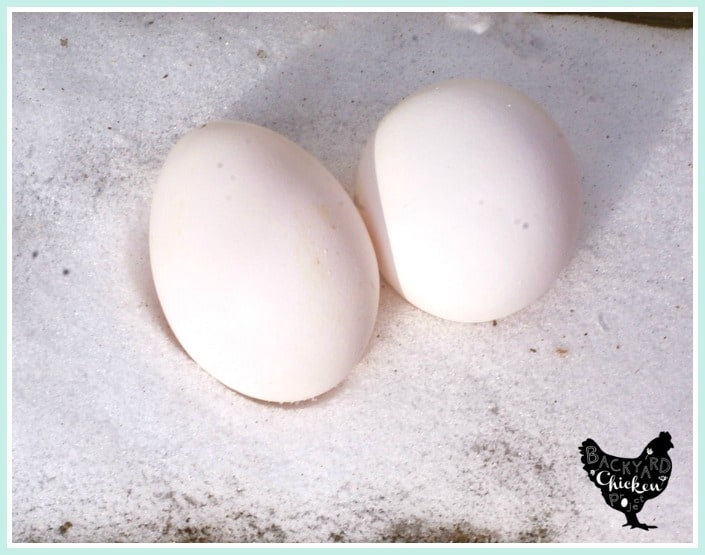The Leghorn is one of the best egg laying chickens you can get. They’re absolute champions when it comes to egg production and can be very sweet birds.
We’ve put together a quick and simple breed spotlight so you can get the facts without the fuss. Find out if the Leghorn is the right chicken for you…
This post contains affiliate links.

Leghorn Chicken Breed Spotlight
Leghorn Pronunciation:
Leg-gern or Leg-Horn
Personality:
Leghorns tend to be skittish and flighty birds. They’re not very interested in personal interactions with people and mostly like to be left alone. Leghorns are incredibly fast runners and are very difficult to catch.
Leghorns are nervous and anxious birds. They may not be the right choice for young children or those who want a cuddly bird.
While some breeds are more akin to certain personality types, the way that they’re raised has a lot to do with temperament. If you spend more time handling your birds from a young age you’ll get a nicer more personable chicken!
Size:
Leghorns are small birds. They’re thin and muscular with twiggy legs. Due to their small stature, Leghorns do not make good dual purpose breeds.
Leghorn hens usually weigh in around 4-5 pounds. Leghorn roosters usually weigh 6-7 pounds.

Leghorn Chicken Appearance:
Leghorn chickens are thin birds. White leghorns are the most popular and available of the many Leghorn color variations. They have bright white feathers. Leghorns come in a variety of other colors as well including brown, black, and red. Leghorns have thin yellow legs free of feathers. They can have a large single comb or a rose comb. Their wattles are large and bright red.
Variations:
Color:
- White
- Light Brown
- Dark Brown
- Buff
- Black
- Columbian
- Silver
- Red
- Cuckoo
- Red-tailed Black
Size:
Leghorns come in standard and bantam size.
Comb:
- Single Comb
- Rose Comb
Laying Skills:
You might need our massive list of 200+ recipes that use a lot of eggs because leghorns are champion egg layers. They can lay over 250 eggs per year. Many Leghorns under 2 years old lay an egg every day.
Leghorn Chicken Eggs:
Leghorns lay large white eggs.

Free-Ranging Skills:
Leghorns are good at foraging and love free ranging. They can find most of their nutritional needs while free ranging.
Climate:
Leghorns are Mediterranean birds that thrive in warm weather. Their large comb and wattles allow them to regulate their body temperature against extreme heat. Leghorns can struggle in the winter due to their thin bodies and large combs. Ensure your chicken coop is free of drafts and has good ventilation to keep your leghorns frostbite-free in winter. Or perhaps choose a cold hardy chicken breed.
History:
“In Northern Italy, near the port of Leghorn, were to be found a landrace of fowls, known as Livornese, that were smallish in body, but which lay very many eggs. In 1852, Captain Gates entered the harbor at Mystic, CT, and arrived with the first importation of Leghorn chickens that were to be ancestors of today’s flocks. The birds were what we now call Brown in color. In 1853 F.J. Kinney received an importation of Brown Leghorns at Boston Harbor, while Mr. Simpson received a shipment of White Leghorns. From this point forward Leghorn chickens began to win America’s heart.”
Source: The Livestock Conservancy
Fun Fact:
Due to the fact that Leghorns are such prolific layers, they are the chosen breed for large egg farms. Large white Leghorn eggs are well known and sold in most supermarkets.
We hope you enjoyed this Leghorn Chicken Breed Spotlight!
Want to stay up to date on the goings-on of Backyard Chicken Project? Our newsletter features chicken tidbits, discounts on poultry products, and each week’s hottest posts!

Bethany Plutowski
Tuesday 11th of August 2020
I have a brown leghorn coloring question. I have a random chick from the hatchery and it looked like the usual light brown leghorn at day old, at 10 wks now it is colored just like a light brown leghorn pullet but it crows, it is very big legged and stands very erect with a big red comb and wattle. question is can they at 10 weeks look just like a pullet but be a cockerel?